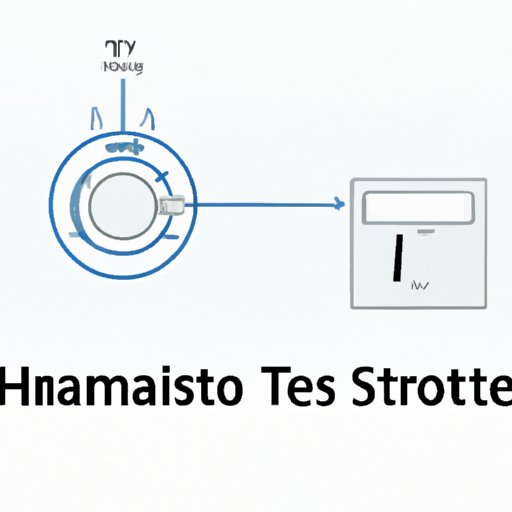
Introduction
Are you tired of your thermostat not working correctly? Resetting your thermostat may be the solution you need. Resetting your thermostat is a vital troubleshooting step to fix any issues you might be experiencing with your thermostat. In this article, we will show you how to reset your thermostat. We will also provide common issues and solutions when resetting your thermostat. We’ll cover best practices for maintaining your thermostat and help you understand technical terms related to thermostats.
How to Reset Your Thermostat
Resetting your thermostat is an essential step to fix any issues you might be having with your HVAC system. Whether you’re experiencing issues with the cooling or heating system, the thermostat is often the best place to start. Here is a step-by-step guide to reset your thermostat.
1. Locate the Thermostat:
The first step is to locate your thermostat. Usually, thermostats are located in centralized areas and easy to find, such as the living room or hallway.
2. Turn Off the Power:
Before you reset your thermostat, you need to turn off the power to the heating or cooling system. You can turn off the power by flipping the circuit breaker or using the on-off switch on your furnace or air handling unit.
3. Remove the Thermostat Cover:
Most thermostats have a cover that needs to be removed to access the reset button. Simply remove the cover by pulling it out from the bottom or unscrewing it from the wall.
4. Find the Reset Button:
Once the cover is removed, you’ll see a reset button on most thermostats. In some thermostats, the reset button may be located under the batteries, so make sure to check there if you don’t see it immediately.
5. Press the Reset Button:
Press the reset button gently, and hold it down for about five seconds. You’ll feel and hear a click. After releasing the button, the thermostat will restart, and you should see the digital display lighting up. You have successfully reset your thermostat.
6. Check the System:
After resetting your thermostat, check the heating or cooling system to see if it’s working correctly. Make sure to follow the manufacturer’s instructions to ensure that your system is functioning correctly. If it’s still not functioning correctly, you may need to call a professional.
Common Issues and Solutions for Resetting Your Thermostat
Even with regular maintenance, thermostats can experience issues that require a reset. While some of these issues may require professional repairs, others can be resolved by resetting your thermostat. Here are some common issues and their respective solutions:
1. Power Outage:
If your thermostat has no power, it won’t work properly. You can reset your thermostat by following the steps earlier. In some cases, you may need to check the circuit breaker or replace the batteries for your thermostat.
2. Thermostat Not Communicating with Your System:
When your thermostat isn’t communicating correctly with your heating or cooling system, the system won’t function correctly. To reset your thermostat, turn off the power, remove the cover, and check if the wires are connected correctly.
3. Sensor Malfunction:
A thermostat sensor malfunction can lead to improper temperature readings, which can cause heating or cooling issues. To fix this, reset your thermostat and check if the sensor is clean. If it’s dirty, clean it gently with a soft brush or cloth.
4. Programming Error:
If you have a programmable thermostat, programming errors can cause issues. To fix this, reset your thermostat, and check if the programming is set correctly. If you are unsure, refer to the owner’s manual or seek professional help.
Tutorial Video on Resetting Different Types of Thermostats
While most thermostats have fundamental resetting procedures, some models’ resetting procedures may be slightly different. Here is a tutorial video on how to reset different types of thermostats.
Best Practices for Maintaining Your Thermostat
Keeping your thermostat in good condition requires regular maintenance. Here are some tips to help keep your thermostat running efficiently:
1. Clean Your Thermostat:
Dust, debris, and other particles can accumulate inside your thermostat, leading to dirty sensors and malfunctioning units. Clean your thermostat regularly by wiping it with a damp cloth or using a soft brush.
2. Replace Batteries:
Some thermostats use batteries to operate. Replace the batteries regularly to ensure your thermostat is running efficiently.
3. Schedule Regular Maintenance:
Sometimes, your thermostat may need professional maintenance to ensure it is running correctly. Schedule regular maintenance checks with a professional to keep your HVAC system running smoothly.
Technical Terms Related to Thermostats
There are a few technical terms related to thermostats that you should know when resetting your thermostat.
1. Stage:
The term “stage” is used to describe heating and cooling processes in HVAC systems. Each time the thermostat starts or stops the HVAC system, this is considered one “stage.”
2. Heat Anticipator:
Heat anticipators control the temperature in your home by shutting off the system before reaching the desired temperature. It’s essential to set the anticipator to match your home’s needs to prevent unnecessary cycling.
3. Dual Fuel:
A line or voltage voltage thermostat that can manage both a heat pump and a gas or electrical furnace while using the best one for the specific climatic condition.
Conclusion
Resetting your thermostat is a quick and simple process that millions of homeowners can perform. In this article, we have shown you how to reset your thermostat, identified common issues and solutions when resetting your thermostat, provided a tutorial video, offered best practices for maintaining your thermostat, and defined technical terms related to thermostats. By following these steps, you can help extend the life of your HVAC system and save money on energy bills. If you have any additional questions or feedback, please leave a comment below.





